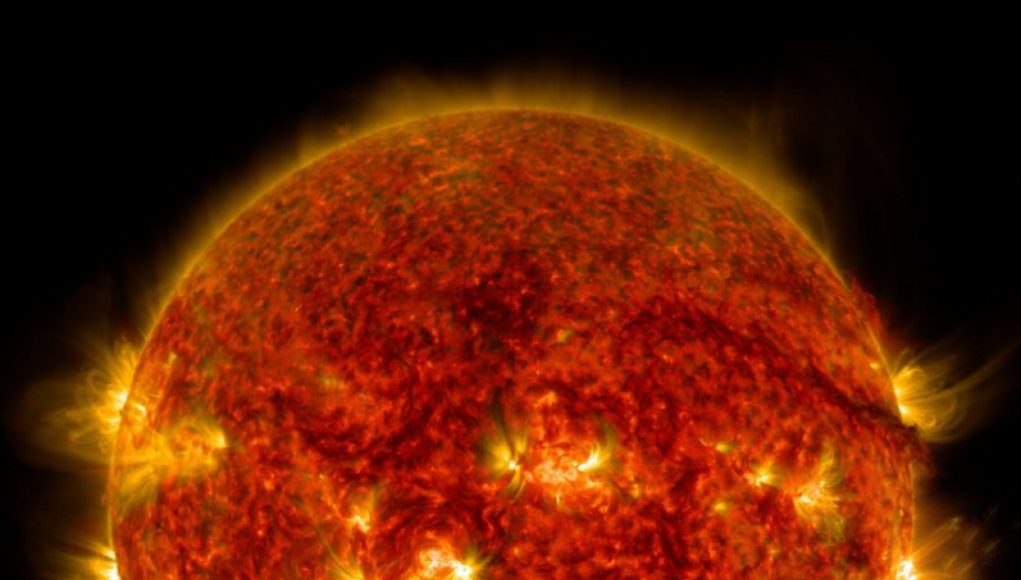The mystery of how life began on Earth has puzzled scientists for years, but a new experiment has shed some light on the subject. It turns out that blasts of solar particles from the young Sun could have kickstarted the process by creating some of the basic components of life. Before the first microbe existed, amino acids had to form in one of the primordial oozes of early Earth. While it was previously thought that lightning might have supercharged the formation of amino acids, a team of researchers from Yokohama National University in Japan and NASA’s Goddard Space Flight Center have found another possibility. The young Sun’s superflares probably helped give rise to the stuff of life.
By studying observations of young, distant stars from NASA’s Kepler mission, the researchers figured out how the nascent Sun most likely behaved: It threw massive tantrums. These blasted Earth with enough energy to break down the atmospheric gases that existed at the time. The Hadean Sun was young and temperamental, erupting in superflares that likely happened at least once a week. Though an earlier study suggests our star was 30 percent dimmer during the Hadean Eon, the frequent superflares were still powerful enough to spark chemical reactions.
The researchers used particle accelerators to investigate how protons from solar superflares could have interacted with Earth’s atmosphere. Their team simulated both solar radiation and lightning bombarding gas particles in a mixture that reflected the early Earth’s atmosphere. These results were also compared with previous work, which used particle accelerators to study the reactions triggered by galactic cosmic radiation. The researchers found that the protons they shot at these gases were more effective at creating amino acids and one of their components, carboxylic acids, than either lightning or galactic cosmic rays.
While the Sun might not have zapped life into Earth, life somehow became what it is from the biomolecules that it helped create. The study also suggests that highly energetic particles from the Sun may have had some part in generating amino acids on Mars. Before it lost most of its atmosphere, ancient Mars was warmer, wetter, and had a thicker atmosphere. It’s possible that it had been at least a temporary haven for life.
The search for what turned chemicals into living organisms still eludes us, but this new experiment has given us a glimpse into the possibilities. Who knows what other secrets the universe holds?
For millennia, humankind has looked up to the stars and the sun with awe and admiration. But a new NASA study has revealed that the sun’s once regular but huge outbursts could have threatened, rather than enhanced, life on Earth.
The new research, published in Nature Communications, explains how the intensity of eruptions from the sun known as coronal mass ejections (CMEs) varied greatly over the course past few billion years. The authors of the study suggest that during the Late Heavy Bombardment, a period of intense meteor bombardments on worlds within the inner Solar System, the Sun’s variable CMEs may have posed a significant danger to life on Earth.
At the time of the Late Heavy Bombardment, 3-4 billion years ago, Earth would have been littered with unshielded asteroids. During CMEs, these space rocks could have been flung with enough force to escape the gravitational pull of Earth, perhaps even reach our neighboring planets and moons.
Tetsuya Fukuhara, a researcher at the Carnegie Institution for Science and the lead author of the study, said “We show that our Sun’s magnetism is one of the factors that can influence the amount of material that can be ejected from the inner Solar System”.
The findings have major implications for understanding the evolutionary history of life on Earth. It is possible that the smaller, but more frequent, CMEs that have become typical of the Sun’s activity in recent history, helped protect the inner Solar System from incoming asteroids.
“The Sun’s radiation environment was much harsher in the early stages of planetary system formation,” Fukuhara said. ”Having this period of increased reactivity could have been beneficial in protecting the Earth from projectiles.”
In the future, researchers hope to better understand exactly how the CMEs impacted life on Earth. The team’s findings give us a fascinating new angle by which to consider the evolution of our planet and could offer new insights into how life survived, and ultimately thrived, in the early solar system.




















